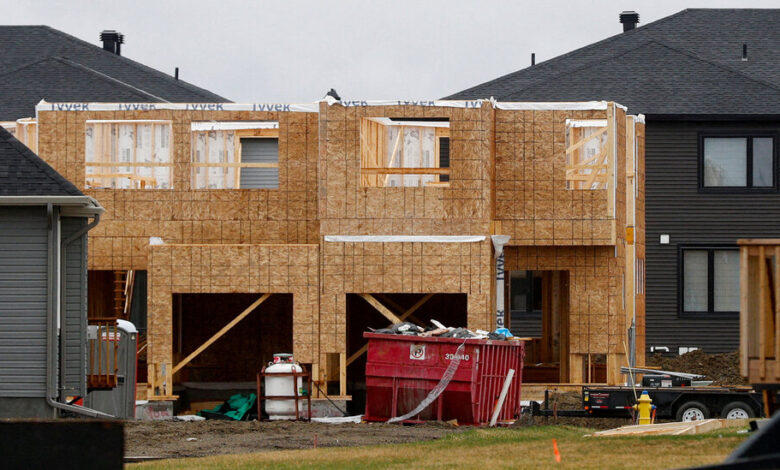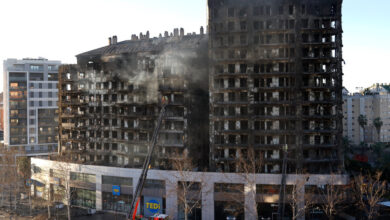
[ad_1]
Charles St-Arnaud, the chief economist at Alberta Central, the central bank for the province’s credit unions, started out his inquiry with a simple question: How far would prices need to fall, or would incomes need to rise, to make housing affordable again in Canada?
The answer for most cities in Canada is “too much.”
Mr. St-Arnaud’s research, published this month, presents a major obstacle to efforts to make housing in Canada more affordable. It suggests that the proposals being offered by many politicians — building more houses to lower prices by increasing supply — are unlikely to make a big difference.
By most measures, houses are now so costly in much of Canada that affordability has reached a four-decade low. Back in the early 1980s, the squeeze was created by mortgage rates of more than 18 percent. Today, of course, it’s the product of a steep increase in prices that took place over about a decade and accelerated during the pandemic. That rise ebbed somewhat when the Bank of Canada increased interest rates, but so far that has not meant substantive price drops.
In the cities where Canada’s real estate mania has been the greatest, Mr. St-Arnaud’s findings are startling. He calculated that prices would need to plummet 39 percent in Toronto, 33 percent in Vancouver and 30 percent in Montreal based on current incomes. Or, to flip things around, incomes would need to grow by 65 percent in Toronto, 50 percent in Vancouver and 43 percent in Montreal.
Mr. St-Arnaud did find some good news. Houses remain affordable in Calgary, Edmonton and Winnipeg. (For his calculations, Mr. St-Arnaud defined affordable housing as not consuming more than 30 percent of its owner’s after-tax income, including utilities, property taxes and insurance. He also assumed that homeowners put 20 percent of the purchase price in a down payment and spread their mortgages out over 25 years — the typical arrangement in Canada.)
He told me that as the numbers had become clear, he had increasingly despaired for younger Canadians who were “trying to get a home, get started with a family and trying to make it.”
The position of the federal government and most provinces is that by stimulating the construction of new housing, Canada can have affordable homes without lowering the value of current homes. While Mr. St-Arnaud agrees that building more houses will help with affordability, he is skeptical that it will be enough to make homes truly affordable. And he noted that few, if any, politicians would have any interest in withstanding the political backlash that would come from doing anything that would push down the value of many Canadians’ most valuable asset, perhaps substantially.
“There are a lot of homeowners right now whose house is their only asset,” he said. “All their money goes to their house. They don’t have any pension fund or savings. Their house is everything. So if it’s no longer appreciating, it might put some financial strains on some of them.”
When I spoke with Robert Hogue, the assistant chief economist at RBC, he said that he agreed that dramatic house price drops that restore affordability are unlikely to occur in cities where housing has become unaffordable. (I didn’t bother asking him about the likelihood of 65 percent raises for those cities’ residents.)
If nothing else, he said, that would require builders to construct more houses than Canada has the capacity to build or to build beyond what developers’ balance sheets can profitably sustain.
He was, however, more hopeful about the affordability of rental housing, which is now also very costly in many cities. One lesson from the pandemic, he said, was that when students were no longer pouring into cities and some residents were moving out of downtowns to rural areas, was that an increase in supply can swiftly lead to lower rents. Just raising vacancy rates to 3 percent, Mr. Hogue said, would make a substantial difference.
“Landlords depend on a flow of income,” he told me. “If a unit is not occupied for a few months, they’re much more willing to deal.”
But Mr. Hogue added that Canadians would not have to abandon homeownership. While the rate of homeownership in Canada fell between 2011 and 2021, it still remained at a robust 66.5 percent.
But ownership in the future will come, he said, with “some compromises” in highly unaffordable cities.
In places like Toronto and Vancouver, Mr. Hogue said, many buyers, particularly those just entering the market, will have to abandon thoughts of a single detached home near downtown and settle for a condo far from the city center. Others may need to move to provinces with lower housing prices, like those in Atlantic Canada.
Conor Dougherty, my colleague on the Business desk, has written about one compromise that has come to the real estate market in the United States: subdivisions of detached houses as small as 400 square feet.
[Read: The Great Compression]
“Ownership affordability — that’s a hard one to fix,” Mr. Hogue said. “You can probably achieve some progress, but to completely fix it to way back to where it was in 2004, I think that’s a stretch.”
He added, “The ownership dream will still be available, but it’ll be different than what the ideal would be for many people.”
Trans Canada
-
A judge in London, Ontario, ruled that a deadly rampage by a man who drove his truck into five members of a Muslim family, killing four of them and injuring a young boy, was an act of terrorism driven by white supremacist ideology.
-
Louise Blouin grew up in the Montreal suburb of Dorval and made a fortune with her second husband though publishing used-car classified ads. Jacob Bernstein vividly tells the story of how after decades as an art-world mogul and a Long Island society fixture, Ms. Blouin wound up representing herself at a bankruptcy hearing in Central Islip, N.Y., earlier this month.
-
A study based partly on Canada’s experience has found that about a quarter of menthol cigarette smokers quit in the year or two after a ban on menthol was imposed.
-
At the request of The New York Times, the Canadian Center for Child Protection conducted a review and found “child sexual abuse imagery involving multiple underage Instagram models from around the world,” my colleagues Jennifer Valentino-DeVries and Michael H. Keller wrote in their chilling investigation into parents who seek stardom for their underage daughters by posting photos of them on Instagram. My colleagues added that in online forums, men sexually attracted to the girls “frequently praise the advent of Instagram as a golden age for child exploitation.”
A native of Windsor, Ontario, Ian Austen was educated in Toronto, lives in Ottawa and has reported about Canada for The New York Times for the two decades. Follow him on Bluesky: @ianausten.bsky.social.
How are we doing?
We’re eager to have your thoughts about this newsletter and events in Canada in general. Please send them to nytcanada@nytimes.com.
Like this email?
Forward it to your friends, and let them know they can sign up here.
Source link




